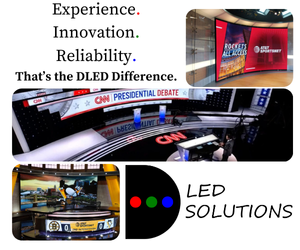Industry Insights: What broadcasters need from modern switchers and playout systems

Subscribe to NCS for the latest news, project case studies and product announcements in broadcast technology, creative design and engineering delivered to your inbox.
In this Industry Insights installment, we examine the technology powering live production, from switchers and playout to ingest systems and infrastructure design.
As control rooms transition from SDI-based setups to IP and cloud-driven architectures, vendors weigh in on the capabilities broadcasters are prioritizing, the role of SMPTE ST 2110 and how hybrid workflows are influencing both purchasing decisions and operational models. The conversation also touches on automation, resource scaling and why gradual migration often beats all-at-once overhauls.
As broadcast operations grow more distributed and dynamic, the control room is no longer a single space – it’s a flexible, interconnected system that must adapt to shifting formats, workflows and expectations.
Key takeaways from this Industry Insights roundtable
- IP is enabling scale: Broadcasters are leveraging IP to scale signal routing, access any source from any system, and rethink legacy SDI chains.
- Switchers must be flexible: Support for multiple formats and protocols, including SDI, NDI, SRT, and ST 2110, is now a baseline expectation.
- Cloud adoption is strategic: Cloud-based ingest and playout offer cost and flexibility benefits, but are often used selectively for overflow or remote ops.
- Automation is advancing: ST 2110’s separation of video, audio, and metadata is driving more responsive and efficient automation systems.
- Migration should be incremental: Vendors recommend hybrid approaches over sudden shifts, allowing SDI and IP to coexist as infrastructure evolves.
What factors should broadcasters consider when selecting a new production switcher?
Klaus Weber, director product marketing, Grass Valley: When selecting a new production switcher, broadcasters should prioritize format and signal compatibility, including native support for HD, UHD, and HDR, along with the ability to perform internal up- and down-conversion between formats. It should also support both SDI and IP-based I/Os to meet current and future infrastructure requirements. Scalability and future-proofing are key, with options to expand I/O, boost processing power, or upgrade software as production demands evolve.
Adam Salkin, senior solutions architect, Diversified: When selecting a new production switcher, broadcasters should consider the availability of TDs skilled in that make and model of switcher resolution, frame rate, or HDR and WCG capabilities. They should also think about 2110 IO capacity — how many in- and outputs. Broadcasters should also know how the 2110 IO connects to ethernet switches. For example, is there an SFP connection per I/O or are there 100, 200, 400-GB connections carrying multiple IO?
Dave Hoffman, business development manager, Americas, Blackmagic Design: While many aim to future-proof their switchers, it’s important to not get tied down to your gear. It’s unrealistic to expect one device to handle every possible format or workflow shift that may come years down the line. Instead, focus on modular and scalable solutions that meet your current production needs, integrate well with your existing setup and that fit your budget.
Christopher McLendon, senior product manager, Vizrt: The first consideration should be how the broadcaster is set up. For instance, you could go with a traditional SDI-only system, if you’re going to put in all the other equipment needed to manage that. This has a lot to do with budgeting, but flexibility is really what broadcasters of all sizes should consider. If scalability is important to the broadcaster, adopting cloud infrastructure should be a consideration.
Scott McQuaid, senior sales support engineer and product manager, switchers, Sony Electronics: When selecting a new production switcher, broadcasters need to consider the advantages of moving to IP. The benefits include the ability to move signals over networks and longer distances. Additionally, it enables a center for the hardware that can be in a different location from your control rooms and control panels. Resource allocation is another factor because newer switchers can allow for smarter and more efficient resource utilization.
What capabilities are broadcasters prioritizing when upgrading production switchers?
Scott McQuaid, senior sales support engineer and product manager, switchers, Sony Electronics: Considering production switchers that accept a variety of input types is a great start. With TriCaster Vizion, for instance, you can bring in SDI, NDI, SRT, and multiple other IP sources, which provides that flexibility that is essential to broadcasters today. Other capabilities available in modern switchers, for instance built-in onboard remote contributions, via Zoom or Teams, ensure that extra support in bringing in sources from anywhere.
In what ways have software-based production switchers affected traditional hardware-based setups?
Roberto Musso, technical director, NDI: Software-based production switchers are reshaping control rooms through flexible, scalable workflows that don’t require dedicated hardware. Producers are able to route and switch broadcast-quality video over standard networks, using off-the-shelf computers. By doing so, they’re able to achieve lower costs and complexity while supporting various production models.
What workflow considerations are broadcasters addressing when migrating ingest and playout to IP-based infrastructures?
John Mailhot, SVP, product management, Imagine Communications: A typical modern control room may be managing 50 or more outbound channels, with additional breakout rooms for live sports and events as needed. IP-based infrastructure supports this increased complexity by allowing any of the playout systems to access any signal on the network. It also gives facility designers the flexibility to move beyond traditional SDI “air chains,” instead using a pool of deployable elements to create finished signals.
Matteo De Martinis, head of product management, media productions, Dalet: Broadcasters migrating ingest and playout to IP-based infrastructures need to focus on ensuring interoperability across systems, maintaining low latency for live content, and achieving scalability for future growth. They also prioritize redundancy and failover mechanisms to ensure reliability. Workflow automation and centralized control are key to managing complex, distributed environments efficiently.
Jan Weigner, CTO, Cinegy: The biggest consideration isn’t technical — it’s avoiding the “big bang” migration trap that’s killed more broadcast projects than I care to count. Broadcasters need systems that handle both legacy SDI and modern IP simultaneously, which is exactly why our hybrid approach exists. You can’t afford downtime when the show must go on, so intelligent migration beats revolutionary overnight changes every single time as well as having the ability to handle anything anyone throws at you last minute.
Miroslav Jeras, CTO, Pebble: IP connectivity is not an end in itself. It is an enabling technology that helps broadcasters evolve their workflows. It supports more flexible production models, allowing a single production chain to deliver multiple outputs — including legacy broadcast, FAST, on-demand streaming, and short-form content — from one setup. When supported by a comprehensive and agile automation system, IP-based infrastructures give broadcasters more freedom in how they operate, scale, and manage content across different platforms.
James Gilbert, SVP, Pixel Power: In terms of playout, we’re seeing broadcasters being able to consolidate multiviewing and monitoring for multiple channels and outputs from multiple rooms down into one or two suites. Automation is helping improve the quality of monitoring and helping free up human resource for other tasks. The key messages here are simplification, improved quality and efficiency.
Martins Magone, CTO, Veset: Broadcast workflows have become more complex and dynamic, and broadcasters are under immense pressure to produce more content than ever before, at lower costs. IP-based systems provide flexibility, efficiency and scalability at levels that SDI simply can’t match. By migrating playout systems to IP-based infrastructure, broadcasters can deliver video streams over IP and leverage all of the benefits that cloud playout brings, such as reduced CapEx and improved agility and flexibility.
James Cranfield, global VP, sales and partnerships, Cinedeck: From an ingest perspective, the shift to IP brings a lot of benefits, particularly when it comes to remote production. With IP-based workflows, broadcasters can produce content anywhere with significantly less hardware and people needed on site, which vastly reduces costs. Media teams can operate from any location and collaborate in real-time, which brings much needed flexibility, and additionally, footage can also be recorded direct to the cloud, which removes bottle necks and streamlines content production because editing teams can begin post-production tasks right away.
Chris Scheck, head of marketing content, Lawo: The short answer is again maximum agility. IP treats audio, video, and control signals as separate essences that can, but do not have to, be used together. Flexible, software-controlled audio matrices are becoming increasingly important even to OB trucks covering big events that involve hundreds of feeds. The ability to set such aspects close to the signal sources or receivers — which is called “edge processing” — allows operators to save on bandwidth.
Graham Sharp, VP, sales and marketing, BCNexxt: IP based infrastructure makes a new level of flexibility and automation available to Broadcasters over traditional hardware appliances, increasing efficiency, reducing costs and increasing reliability. New and exciting architectures can now be deployed in-cloud, on premise or with hybrid models, utilizing the dynamic scaling of the cloud to add and remove computing resources based on the changing requirements of the content, for example when required for a live event. At a macro level, channels can be spun up in minutes not months, giving broadcasters and service providers new financial opportunities for pop up channels for special events on a pay as you go basis and without the constraints of large capital investments.
Chris Pulis, CTO, Globecast: Broadcasters must ensure real-time failover and the same reliability as traditional systems, particularly because IP introduces greater complexity, requiring more advanced monitoring across multiple points in the network rather than a single pipeline. Effective visibility and measurement throughout the chain are critical to identifying and resolving issues quickly.
How has the adoption of ST 2110 influenced ingest and playout automation practices?
John Mailhot, SVP, product management, Imagine Communications: While SDI infrastructure is inherently rigid — with a fixed number of output and playout server ports − the IP routing fabric supports deployable software, allowing ingest and playout tasks to be dynamically assigned across networked computing infrastructure. These services become available on the router when deployed, regardless of the physical computer they’re running on, allowing facilities to scale resources throughout the day and perform maintenance with a level of agility that SDI could never offer. Modern automation systems must complement this orchestrated deployment model.
Matteo De Martinis, head of product management, media productions, Dalet: With devices being automatically detected, configured, and controlled without manual intervention broadcasters gain more responsive, scalable, and intelligent automation workflows that adapt quickly to changing production needs.
Bill Lawler, technical product manager, Telestream: With ST 2110, the separation of video, audio, and metadata into discrete streams gives broadcasters greater flexibility in automating ingest and playout processes — allowing independent control over elements like audio routing and metadata handling without signal conversion. IP-based infrastructure also enables more efficient resource sharing, letting multiple productions access the same ingest and playout systems for better load balancing and reduced hardware duplication. Additionally, the move to IP supports remote and cloud-based workflows, allowing automation systems to be managed centrally or off-site, which enhances operational agility and supports modern distributed production models.
Miroslav Jeras, CTO, Pebble: Playout automation has been central to broadcasting for more than three decades, delivering content seamlessly and reliably. IP architectures, whether compressed or uncompressed, provide the sources that automation systems switch to air — though switching in IP brings different timing considerations compared to SDI. Still, IP’s flexibility allows content sources to be distributed across locations or systems, enabling more dynamic and adaptable setups. This supports greater agility in operations, even though careful planning is needed to manage timing and integration.
Martins Magone, CTO, Veset: Adoption of ST 2110 has paved the way for cloud playout; without the introduction of ST 2110, there wouldn’t be real SDI-quality alternatives for both compressed and uncompressed video signal processing. With cloud playout’s extensive automation capabilities, repetitive and time-consuming tasks such as ingest, QC verification and scheduling can all be automated. This allows broadcasters to allocate resources elsewhere, which increases efficiency and also saves costs.
James Cranfield, global VP, sales and partnerships, Cinedeck: ST 2110 offers the scalability that isn’t always possible with SDI, making it perfect for large multi-channel production workflows supporting 1080p, UHD and HDR. It has the ability to handle multi-channel workflows efficiently, and by separating video, audio and metadata for playout it also reduces network bandwidth. The result is a more fluid, automated approach to ingest, where scale no longer demands large infrastructure.
Graham Sharp, VP, sales and marketing, BCNexxt: ST 2110 is definitely a valuable contribution and mezzanine format, but in many new Cloud and Hybrid architectures, where the content is read directly from the library, it is not required. Modern IP based architectures enable designs with the minimum amount of transcoding; library files are read natively and transformed into the transmission stream format directly, and live streams ingested in their native SRT or JPEG XS formats are inserted directly into the transmission stream. This focus on the delivery format dramatically reduces transcoding steps and therefore complexity, reducing costs and increasing quality through reducing the concatenation of encoding.
Chris Pulis, CTO, Globecast: ST 2110 encourages broadcasters to focus on how video and audio are delivered at the packet level over a network. This demands a deeper understanding of infrastructure design and performance at a more granular level, and in doing so, raises the standard for quality and robustness across ingest and playout systems.
What role does cloud technology currently play in broadcasters’ ingest and playout strategies?
John Mailhot, SVP, product management, Imagine Communications: Certain ingest and playout tasks — such as ingest processes that run only a few hours a day or regional and local splits of mainline networks — are ideally suited to the part-time use model of cloud computing. For many broadcasters, the optimal approach is to maintain a baseline level of in-house capacity and push to the cloud when needed. This is made possible by dynamic orchestration tools that support operational decision-making about where and how to deploy tasks — with consideration for both budget and criticality.
Bill Lawler, technical product manager, Telestream: Cloud technology enables broadcasters to deploy ingest and playout systems flexibly, supporting hybrid or cloud-native models that adapt to changing operational needs. With remote access and control capabilities, cloud platforms allow decentralized teams to manage workflows from anywhere, streamlining collaboration and reducing turnaround times. Additionally, cloud technologies offer powerful automation and orchestration tools that simplify tasks like scheduling, QC, and captioning, helping broadcasters increase efficiency and accelerate time-to-air.
Jan Weigner, CTO, Cinegy: In broadcast, we have a lot of heavy lifting to move data in and out, and every hour, every megabyte gets paid for somehow. Smart broadcasters use cloud for specific advantages like disaster recovery and overflow capacity while keeping primary operations where they control costs and latency. The hybrid approach wins because it leverages cloud benefits without cloud dependency — and without the sticker shock.
Miroslav Jeras, CTO, Pebble: In practical terms, we see broadcasters still keen to retain playout on their own sites, with the equipment — even if it is a cloud-like data centre — under their own physical control. Often, though, they will use the cloud to provide disaster recovery, or at least to provide the synchronization for another terrestrial DR site. Again, the cloud, and data acceleration, and security in transit, are simply enablers for the broadcaster’s primary goals of meeting the expectations of viewers and advertisers.
James Gilbert, SVP, Pixel Power: It’s very much a case of horses for courses here. The ideal scenario for broadcasters, I think, is finding a technology partner who can say “whatever you want” when asked about the kinds of feeds their playout solutions can handle. A solution that can process SDI, 2110, audio and ancillary data seamlessly clearly offers big advantages for broadcasters who want the flexibility to pick and choose their workflow as the situation dictates.
Martins Magone, CTO, Veset: Cloud technology is playing an increasingly important part in all aspects of broadcaster strategies, and that includes playout, and we’re seeing an increasing number of broadcasters moving playout to the cloud as they set out to future-proof their operations. Being able to respond quickly to changing needs is a critical requirement for broadcasters today and cloud playout delivers the required levels of flexibility and agility. When playout is cloud-based, broadcasters can operate more flexibly and quickly, easily creating and launching new channels, all without investment in hardware and associated infrastructure.
James Cranfield, global VP, sales and partnerships, Cinedeck: Cloud-based ingest brings a number of benefits including cost savings because hardware is no longer required, and overprovisioning can be avoided; improved efficiency because workflows are streamlined; and scalability because ingest resource can be quickly and easily spun up and down. It streamlines workflows because edit-ready content can be captured direct to the cloud enabling media operators to begin editing content straight away. This is particularly valuable in fast-paced productions such as reality TV, where agility and immediate access to footage are key.
Peter Fitton, solutions architect, Ross Video: By leveraging the cloud, broadcasters can ingest content from diverse sources — including live feeds, remote contributors, and social media platforms. That same cloud infrastructure supports agile playout capabilities, including automated scheduling, dynamic ad insertion, and rapid deployment of pop-up or event-based channels. Sometimes, customers come to us wanting to do everything in the cloud, but once we talk it through, they see that it might not be the best fit. Other times, they plan to outfit multiple global sites with hardware, and we realize that a cloud-based approach might solve that more efficiently.
Graham Sharp, VP, sales and marketing, BCNexxt: The adoption of cloud playout has suffered a longer than usual trough of disillusionment as early adopters merely lifted and shifted server-based software onto virtual machines in the cloud. This approach was both costly and unreliable and created a push back in the industry that we are barely through. Now we have truly cloud native software capable of utilizing the clouds’ ability to dynamically scale and this is a game changer but is only just starting to be adopted.
How have hybrid or multi-site workflows influenced ingest and playout system design and implementation?
John Mailhot, SVP, product management, Imagine Communications: While many operators are consolidating real estate portfolios and centralizing operations, this paradoxically increases the enterprise risk of facility unavailability — driving many to adopt a multi-site and/or a ground-cloud hybrid strategy. Modern orchestration and automation tools enable true hybrid operation across physical sites and ground-and-cloud pairings, mirroring content and playlists and allowing operators at either location to manage operations that span both.
Jan Weigner, CTO, Cinegy: Hybrid workflows have fundamentally changed how we think about location in broadcast operations — you can ingest in one city, process in another, and playout from a third, all seamlessly integrated. This isn’t just technical flexibility; it’s operational resilience that lets broadcasters optimize for everything from talent costs to disaster recovery without architectural constraints. When your infrastructure is software-defined, geography becomes just another configuration option instead of a limiting factor.
Miroslav Jeras, CTO, Pebble: Today, no-one would think of planning a new playout automation architecture that did not include highly secure remote access, so any piece of equipment can be on any site or in the cloud, with the operator controlling the complete platform at any other location.
Martins Magone, CTO, Veset: The broadcast industry is continuing to move away from a centralized model to one that sees teams and facilities operating from different locations, and with an increasing number of services and functions sitting in the cloud. Broadcasters need systems that can span locations, integrate with on-prem and cloud infrastructure, and still operate as a cohesive whole. These needs are pushing playout systems to be more flexible and interoperable by design, as well as accessible by teams across different locations.
James Cranfield, global VP, sales and partnerships, Cinedeck: In the complex broadcast workflows that are typical today, production, editing and content processing teams increasingly operating from different locations. IP has become a critical workflow requirement because it enables geographically dispersed teams to collaborate in real time to produce content quickly and at a lower cost. It’s also essential that ingest systems are well-designed so that content is saved in the right formats and with all necessary associated data to enable editors and media operators to efficiently process and manage the content throughout the entire supply chain.
Graham Sharp, VP, sales and marketing, BCNexxt: The cloud’s global nature enables multiple opportunities to architect redundant systems, either across local zones or geographic regions or even on premises in hybrid systems, seamlessly switching between them if an error is detected in one of the streams. Pop-up channels for sporting and other premium events can be spun up and shut down in minutes and paid for on a pay-as-you-go basis, providing unheard of agility to start and end new services, all without costly investment in new equipment and support staff. With these new cloud native architectures, multi-site and hybrid systems become easy to implement as long as there is sufficient bandwidth between sites and from the ground to the cloud — the architectures themselves deliver much of the contribution and distribution requirements, simply and cost effectively.
Chris Pulis, CTO, Globecast: Hybrid and multi-site workflows support real-time access between geographically distant facilities, improving business continuity and disaster recovery by ensuring content is instantly available across locations. Broadcasters are also exploring multi-region and multi-cloud strategies to protect against the rare but real possibility of full cloud region outages. This distributed approach enhances resilience and strengthens long-term infrastructure planning.
Subscribe to NCS for the latest news, project case studies and product announcements in broadcast technology, creative design and engineering delivered to your inbox.







tags
2110, Adam Salkin, Automation, BCNexxt, Bill Lawler, Blackmagic Design, Broadcast Automation, Broadcast Ingest, Broadcast Workflow, Chris Pulis, Chris Scheck, Christopher McLendon, Cinedeck, Cinegy, cloud based playout, Dalet, Dave Hoffman, Diversified, Globecast, Graham Sharp, Grass Valley, Imagine Communications, James Cranfield, James Gilbert, Jan Weigner, John Mailhot, Klaus Weber, Lawo, Mārtiņš Magone, Matteo De Martinis, Miroslav Jeras, NDI, Pebble, Peter Fitton, Pixel Power, Playout Control System, Roberto Musso, Ross Video, Scott McQuaid, SMPTE ST 2110, Sony, Sony Electronics, Switchers, Telestream, Veset, Vizrt
categories
Broadcast Automation, Broadcast Equipment, Heroes, Industry Insights, IP Based Production, Playout & Video Transmission, Production Switchers, Voices